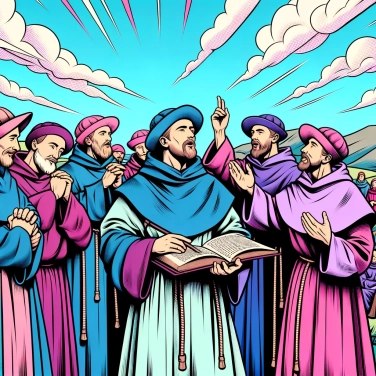The scribe monks were important in the Middle Ages because they were responsible for copying and preserving ancient texts, thus ensuring the transmission of knowledge and culture throughout the centuries.

In the Middle Ages, books were extremely rare and valuable. Each text had to be copied by hand, and that’s where the scribes came into action. In their abbeys, these guys patiently copied ancient manuscripts, often preventing works from disappearing completely over time. Without them, we would have lost a ton of knowledge inherited especially from the Greeks and Romans. They meticulously preserved religious works, but also those on medicine, astronomy, and even philosophy, thus allowing future generations access to a vast intellectual heritage. In short, thanks to the silent dedication of these monks, a whole part of our history and culture has been passed down to us.
Before the advent of printing, copying monks were the only ones able to disseminate knowledge by carefully hand-copying each work. Based in workshops called scriptoriums, they spent their days transcribing religious texts, but also scientific, philosophical, or literary works that sometimes came from very far away. Without their labor, much of the knowledge of antiquity, such as that of Aristotle or Plato, could have completely vanished. Their copies then circulated among monasteries, universities, and royal courts, allowing ideas to travel and people to gradually educate themselves. These books were rare and precious, but they provided access to knowledge well beyond the walls of the cloisters.
In the Middle Ages, the majority of writings were in Latin. But little by little, copying monks began to transcribe texts in what are called the vernacular languages, that is to say, the languages spoken by the people. They contributed to fixing and stabilizing these languages by putting them in writing: thanks to their manuscripts, popular dialects like Old French, Old English, or Old German were able to establish themselves durably. Without them, many of these languages would not have had a solid and structured foundation. Some copyists even adapted the Latin alphabet to incorporate new sounds unique to these spoken languages, actively participating in their written evolution. In short, if your texts today resemble something other than a string of Latin letters, it's partly thanks to these medieval monks.
The scribes played a crazy role in the enhancement of religious art. Their manuscripts were not just simple books copied in bulk: they were also often incredible visual works. These artist monks created illuminations, intricate illustrations depicting biblical scenes, saints, fantastical animals, or decorative patterns. Thanks to their crazy patience and attention to detail, they established a rich and sophisticated artistic style that has endured through time. Some of these books, like the famous Book of Kells, are now considered treasures of medieval art. These illuminated manuscripts also helped to make faith more concrete and alive in the eyes of ordinary people, at a time when almost no one could read. They struck minds and made the religious experience intense and accessible. Without these copyists, it's uncertain whether religious art would have flourished as much in the Middle Ages.
Copying a single manuscript could take several months, or even years, depending on the complexity and length of the text, making handwritten books rare and valuable objects.
The parchment used by the copying monks was primarily made from animal skins, usually sheep or calf; it took about 200 skins to produce a single complete Bible.
Copying errors were common; some ancient manuscripts show corrections made by the scribes themselves, sometimes with apologies inserted directly into the text when they made mistakes.
The room where the scribes worked in the monasteries was called the 'scriptorium'; it was an extremely quiet and bright place, specifically designed to enhance their concentration.

100% of respondents passed this quiz completely!
Question 1/5